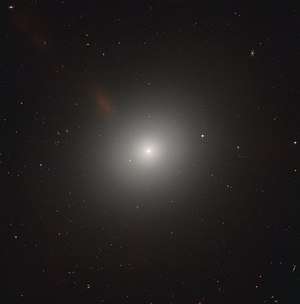Messier 105
Messier 105 or M105, also known as NGC 3379, is an elliptical galaxy located 36.6[2] million light years away in the equatorial constellation of Leo. It was discovered by Pierre Méchain on 24 March 1781, just a few days after he discovered the nearby galaxies Messier 95 and Messier 96.[7] This galaxy is one of several that were not originally included in the original Messier Catalogue compiled by Charles Messier. Messier 105 was included in the catalog only when Helen S. Hogg found a letter by Méchain describing Messier 105 and when the object described by Méchain was identified as a galaxy previously named NGC 3379.[7]
| Messier 105 | |
|---|---|
 | |
| Observation data (J2000 epoch) | |
| Constellation | Leo |
| Right ascension | 10h 47m 49.600s[1] |
| Declination | +12° 34′ 53.87″[1] |
| Helio radial velocity | 908 km/s[2] |
| Distance | 36.6 Mly (11.22 Mpc)[2] |
| Group or cluster | Leo I Group[3] |
| Apparent magnitude (V) | 10.2[4] |
| Characteristics | |
| Type | E1[5] |
| Apparent size (V) | 5′.4 × 4′.8[4] |
| Other designations | |
| M105, NGC 3379, PGC 32256, UGC 5902[6] | |
This galaxy has a morphological classification of E1,[5] indicating a standard elliptical galaxy with a flattening of 10%. The major axis is aligned along a position angle of 71°. Isophotes of the galaxy are near perfect ellipses, twisting no more than 5° out of alignment, with changes in ellipticity of no more than 0.06. There is no fine structure apparent in the isophotes, such as ripples.[8] Observation of giant stars in the halo indicate there are two general populations: a dominant metal-rich subpopulation and a weaker metal-poor group.[3]
Messier 105 is known to have a supermassive black hole at its core whose mass is estimated to be between 1.4×108 and 2×108 M☉.[9] The galaxy has a weak active galactic nucleus of the LINER type with a spectral class of L2/T2, meaning no broad Hα line and intermediate emission line ratios between a LINER and a H II region.[10] The galaxy also contains a few young stars and stellar clusters, suggesting some elliptical galaxies still form new stars, but very slowly.[11]
This galaxy, along with its companion the barred lenticular galaxy NGC 3384, is surrounded by an enormous ring of neutral hydrogen with a radius of 200 kiloparsecs (650 kilolight-years) and a mass of 1.8×109 M☉ where star formation has been detected.[12] Messier 105 is one of several galaxies within the M96 Group (also known as the Leo I Group), a group of galaxies in the constellation Leo. The group also includes the Messier objects M95 and M96.[13][14][15][16]
References
- Skrutskie, M. F.; et al. (February 2006), "The Two Micron All Sky Survey (2MASS)", The Astronomical Journal, 131 (2): 1163–1183, Bibcode:2006AJ....131.1163S, doi:10.1086/498708.
- Tully, R. Brent; et al. (August 2016), "Cosmicflows-3", The Astronomical Journal, 152 (2): 21, arXiv:1605.01765, Bibcode:2016AJ....152...50T, doi:10.3847/0004-6256/152/2/50, 50.
- Lee, Myung Gyoon; Jang, In Sung (May 2016). "Dual Stellar Halos in the Standard Elliptical Galaxy M105 and Formation of Massive Early-type Galaxies". The Astrophysical Journal. 822 (2): 17. arXiv:1601.06798. Bibcode:2016ApJ...822...70L. doi:10.3847/0004-637X/822/2/70. 70.
- "NASA/IPAC Extragalactic Database". Results for M105. Retrieved 16 November 2006.
- Tian, Yong; Ko, Chung-Ming (October 2016), "Dynamics of elliptical galaxies with planetary nebulae in modified Newtonian dynamics", Monthly Notices of the Royal Astronomical Society, 462 (1): 1092–1100, arXiv:1606.06815, Bibcode:2016MNRAS.462.1092T, doi:10.1093/mnras/stw1697
- "M 105". SIMBAD. Centre de données astronomiques de Strasbourg. Retrieved 19 December 2009.
- Jones, K. G. (1991). Messier's Nebulae and Star Clusters (2nd ed.). Cambridge University Press. ISBN 978-0-521-37079-0.
- Statler, Thomas S. (July 1994), "The intrinsic shape of NGC 3379", The Astronomical Journal, 108 (1): 111–127, Bibcode:1994AJ....108..111S, doi:10.1086/117050
- Shapiro, Kristen L.; et al. (2006). "The black hole in NGC 3379: a comparison of gas and stellar dynamical mass measurements with HST and integral-field data". Monthly Notices of the Royal Astronomical Society. 370 (2): 559–579. arXiv:astro-ph/0605479. Bibcode:2006MNRAS.370..559S. doi:10.1111/j.1365-2966.2006.10537.x.
- Eracleous, Michael; et al. (March 2010). "Spectral Energy Distributions of Weak Active Galactic Nuclei Associated with Low-Ionization Nuclear Emission Regions". The Astrophysical Journal Supplement. 187 (1): 135–148. arXiv:1001.2924. Bibcode:2010ApJS..187..135E. doi:10.1088/0067-0049/187/1/135.
- Ford, Alyson; Bregman, J. N. (2012). "Detection of Ongoing, Low-Level Star Formation in Nearby Ellipticals". American Astronomical Society. 219: 102–03. Bibcode:2012AAS...21910203F.
- Thilker, David A.; et al. (2009). "Massive star formation within the Leo 'primordial' ring". Nature. 457 (7232): 990–993. Bibcode:2009Natur.457..990T. doi:10.1038/nature07780. PMID 19225520.
- Tully, R. B. (1988). Nearby Galaxies Catalog. Cambridge University Press. ISBN 978-0-521-35299-4.
- Fouque, P.; et al. (1992). "Groups of galaxies within 80 Mpc. II – The catalogue of groups and group members". Astronomy and Astrophysics Supplement. 93: 211–233. Bibcode:1992A&AS...93..211F.
- Garcia, A. (1993). "General study of group membership. II – Determination of nearby groups". Astronomy and Astrophysics Supplement. 100: 47–90. Bibcode:1993A&AS..100...47G.
- Giuricin, G.; et al. (2000). "Nearby Optical Galaxies: Selection of the Sample and Identification of Groups". Astrophysical Journal. 543 (1): 178–194. arXiv:astro-ph/0001140. Bibcode:2000ApJ...543..178G. doi:10.1086/317070.
External links
| Wikimedia Commons has media related to Messier 105. |
- Messier 105 on WikiSky: DSS2, SDSS, GALEX, IRAS, Hydrogen α, X-Ray, Astrophoto, Sky Map, Articles and images
- "StarDate: M105 Fact Sheet"
- SEDS: Elliptical Galaxy M105
- ESA/Hubble image of M105
- Gray, Meghan; Merrifield, Michael. "M105 – Elliptical Galaxy". Deep Sky Videos. Brady Haran.
